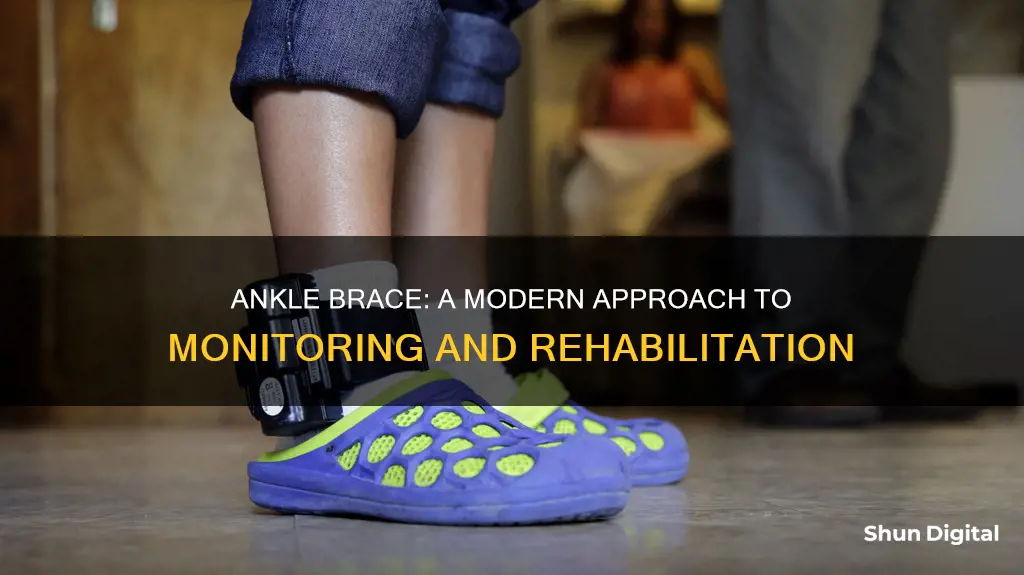
Electronic monitoring is a form of surveillance that uses an electronic device, often referred to as an ankle monitor, bracelet, or shackle, which is affixed to an individual's ankle. This technology is used as an alternative to incarceration, particularly during probation, parole, or as a condition of bail. While it is touted as a more humane option, the high costs associated with electronic monitoring can lead to financial burdens and even result in individuals being sent back to jail. The devices are also criticised for their impact on mental health and the stigma they carry.
| Characteristics | Values |
|---|---|
| Purpose | Surveillance, monitoring, tracking |
| Use | People on bail, probation, parole, facing immigration proceedings |
| Appearance | Bulky, fist-sized, black box, bracelet, shackle, tether, rope, digital shackle |
| Functionality | GPS tracking, radio frequency technology, two-way communication |
| Cost | $3-$35 per day, $100-$200 setup charge, $105 per week |
| Benefits | Cost-effective, reduces prison population, reduces chance of reoffending |
| Drawbacks | Expensive, stigmatising, inhumane, restrictive, stressful, humiliating, causes social isolation |
What You'll Learn

Who pays for electronic monitoring?
Electronic monitoring devices, commonly known as ankle bracelets or ankle shackles, are used to record the location of their wearers. These devices are worn by people awaiting trial, serving probation and parole, and facing immigration proceedings.
The cost of electronic monitoring is a significant concern, with fees ranging from $3 to $35 per day, in addition to initial setup charges that can reach $200. In some cases, individuals may be required to pay rental and battery fees, further increasing the financial burden. The U.S. government pays for the monitors for some federal prisoners and detainees, but states and cities often pass the cost on to those wearing the devices. This has led to concerns about the impact on low-income individuals, who may struggle to afford the fees associated with electronic monitoring.
In St. Louis, for example, defendants are required to pay a private company, Eastern Missouri Alternative Sentencing Services (EMASS), $10 per day for their GPS monitoring. This has resulted in individuals incurring significant debts, with some facing the threat of returning to jail if they cannot keep up with the payments. Similar issues have been reported in other cities, where defendants are put on “offender-funded” payment plans that may cost more than their bail, and where private companies can initiate criminal court proceedings if payments are missed.
The financial burden of electronic monitoring can have far-reaching consequences, affecting individuals' ability to work, access necessary services, and maintain connections with their families and communities. It is important to consider the impact of these costs on vulnerable individuals and explore alternatives or financial assistance to ensure that electronic monitoring does not become a form of digital incarceration for those who cannot afford the associated fees.
How Monitor Size Impacts Website Viewing Experience
You may want to see also

How does electronic monitoring affect the wearer's life?
Electronic monitoring, often in the form of an ankle bracelet or shackle, is a form of surveillance that tracks the location of the wearer. This method of monitoring is used for people awaiting trial, on probation or parole, or facing immigration proceedings.
Electronic monitoring can have a significant impact on the wearer's life, and there are several ways in which this impact can be negative. Firstly, the cost of wearing an electronic monitor can be high, with fees ranging from $3 to $35 a day, in addition to initial setup charges of up to $200. This can be particularly burdensome for households that are already struggling financially following the incarceration of a loved one.
The stigma associated with wearing an electronic monitor can also lead to social isolation and stress, exacerbating mental health issues such as depression and anxiety. The visibility of the monitor can result in negative judgement from others, and may make it difficult for the wearer to find and keep a job. This can be especially true for jobs that require a certain dress code, as the monitor may be difficult to conceal.
Electronic monitoring can also restrict the wearer's movement, with some people on monitors being given curfews or only being allowed to leave their homes for specific reasons. This can make it difficult to carry out basic tasks such as buying groceries or visiting family members.
In addition, technical failures of the monitoring device can result in the wearer being sent to prison, even if they have not broken the terms of their monitoring program.
However, it is important to note that electronic monitoring can also have some positive effects on the wearer's life. For example, it can be seen as a more humane alternative to incarceration, allowing people to stay with their families and maintain some level of freedom. Additionally, electronic monitoring can help with rehabilitation and can provide an objective way to track a person's progress.
Monitoring Hotspot Usage: A Comprehensive Guide to Tracking Data
You may want to see also

How does electronic monitoring affect the wearer's mental health?
Electronic monitoring involves the use of an electronic device, often affixed to the ankle, to track an individual's location. This technology is used for people on bail or probation, as well as in healthcare and immigration contexts. While it is promoted as a humane alternative to jail, electronic monitoring can have negative impacts on the mental health of those who wear these devices.
The stigma associated with wearing an ankle monitor can lead to social isolation and stress, exacerbating depression and anxiety for the wearer. The devices can also restrict movement and limit the ability to work, visit family, or participate in social activities. This can create a sense of being constantly punished and monitored, even after release from jail. The financial burden of paying for the devices and associated fees can also cause significant stress and anxiety, potentially leading to further debt and even a return to jail if payments are not made.
In addition, the use of electronic monitoring in forensic mental health settings has raised concerns about its coercive nature and potential violation of human rights. While it may be beneficial as part of an individualised risk management plan with the valid consent of the patient, coercive use of electronic monitoring can undermine therapy and increase risks to the community.
Furthermore, the accuracy and reliability of electronic monitoring devices have been questioned, with malfunctions and false alarms leading to further anxiety and potential returns to jail. The use of these devices also raises privacy concerns, as they collect and transmit personal data.
Overall, while electronic monitoring may have some benefits, it is important to carefully consider the potential impacts on the mental health and well-being of those who are subjected to this form of surveillance.
Blind Spot Monitor: Standard or Optional in 4Runners?
You may want to see also

How does electronic monitoring affect the wearer's employment?
Electronic monitoring, often in the form of an ankle bracelet or shackle, can have a significant impact on a wearer's employment and ability to find work. The stigma associated with these devices can lead to social isolation and stress, exacerbating depression and anxiety for the wearer. The devices are often clearly visible, making it difficult for the wearer to conceal the fact that they are undergoing some form of punitive measure. This can make it challenging for them to find and keep a job, impacting their social status, self-confidence, and ability to rehabilitate.
The restrictions on movement imposed by electronic monitoring can also interfere with work and school schedules, making it difficult for individuals to balance their obligations. In the case of Michael Tafolla, a man from Chicago, he struggled to get his approved movement hours adjusted after being released on an ankle monitor. He was told by his parole officer that he had to choose between his internship and his job, as he was "doing too much." This restriction on his movement made it challenging for him to work, go to school, and take care of basic needs such as buying soap and clothes.
Additionally, the fees associated with electronic monitoring can be a financial burden, especially for individuals from impoverished backgrounds. These fees can amount to hundreds of dollars per month, creating an additional challenge for individuals trying to rebuild their lives after incarceration.
Furthermore, electronic monitoring can lead to physical jails and prisons for minor technical violations, charging malfunctions, and false alarms. This was the case for Daehaun White, who was arrested and sent back to jail because he failed to acquire and pay for his GPS monitor within 24 hours of his release.
Overall, while electronic monitoring is intended as a humane alternative to incarceration, it can have significant negative consequences on the wearer's employment and overall well-being.
Removing Crayon Marks from LCD Monitors
You may want to see also

How does electronic monitoring affect the wearer's relationships?
Electronic monitoring can have a significant impact on the wearer's relationships, and there are several factors to consider when examining its effects. Firstly, the stigma associated with wearing an ankle monitor can lead to social isolation and stress, affecting the wearer's mental health and well-being. The visible presence of the monitor can result in judgement and negative perceptions from others, causing the wearer to feel ashamed or embarrassed. This can lead to a strain on relationships with family, friends, and the wider community.
Secondly, the restrictions imposed by electronic monitoring can limit the wearer's ability to participate in social activities, family events, and maintain employment. The need to stay within a certain geographical area or adhere to a strict schedule can make it difficult for the wearer to spend time with loved ones or attend important events. This can create a sense of resentment and frustration, not only for the wearer but also for their family and friends, who may feel like they are being punished for the wearer's actions.
Thirdly, the financial burden of electronic monitoring can also strain relationships. In some cases, the wearer is required to pay daily or monthly fees for the device, which can be a significant expense, especially for those from low-income backgrounds. This financial strain can affect the wearer's ability to provide for their family and may lead to tension and conflict within the household.
Furthermore, electronic monitoring can impact the dynamic between the wearer and their partner or spouse. The constant surveillance and restrictions on movement can create a sense of distrust and suspicion in the relationship, leading to a breakdown in communication and intimacy. The stress and anxiety associated with electronic monitoring can also affect the wearer's ability to maintain a healthy and fulfilling relationship with their partner.
Lastly, electronic monitoring can have a particularly detrimental effect on the relationship between parents and their children. The inability to fully participate in their children's lives, attend school events or extracurricular activities, can create a sense of distance and disconnection. The children may also experience stigma or bullying due to their parent's situation, further complicating the parent-child relationship.
Overall, electronic monitoring can have far-reaching consequences on the wearer's relationships, affecting their mental health, social connections, and family dynamics. It is important to consider these impacts when implementing such measures and explore alternative solutions that balance the need for surveillance with the well-being of the individuals involved.
Internet Monitoring: How Often Are We Tracked Online?
You may want to see also
Frequently asked questions
Electronic monitoring (EM) is a tool used in community corrections to promote accountability and compliance. It is often associated with ankle monitors or bracelets that use GPS tracking systems to record the location of the wearer.
Electronic monitoring devices use GPS or radio frequency technology to track an individual's location. The data is transmitted to a base station or monitoring company, which can notify authorities if the individual violates the terms of their release, such as a curfew or restricted areas.
Individuals awaiting trial, serving probation or parole, or facing immigration proceedings may be subject to electronic monitoring as a condition of their release. It is also used in healthcare settings and for immigration monitoring.
Proponents of electronic monitoring argue that it reduces prison populations, helps individuals transition from incarceration to the community, and reduces the chances of individuals returning to jail. It is also considered more cost-effective than incarceration, saving money for local and federal agencies.
Critics argue that electronic monitoring amounts to a form of "digital incarceration" or "e-carceration", restricting individuals' movements and charging them fees for their own surveillance. It has been criticized for exacerbating systemic inequities, stigmatizing wearers, and causing mental health issues due to stress and social isolation.







